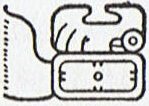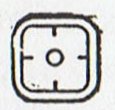2. The top part of chikin is a manik sign, and it has a 'water-filled hole' at bottom right, under the thumb:
Below manik there is a kin (Sun) sign, a double-rimmed 'cartouche' with a little single-rimmed circle in its center and with 2 short marks in each direction. But the basic kin sign has only 1 such short mark in each direction, which probably indicates 'day-time' in contrast to the 'night-time' version with double marks. Kin signifies both 'Sun' and 'day'. The left part of chikin is a 'wing-affix', says Gates in his An Outline Dictionary of Maya Glyphs. It "... may be taken as a time-determinative, and not limited to the single day, its chief connection". This is reasonable because the number of 'feather marks' is variable, in Chikin above it is 13. Chikin has Sun in a 'night position' below the horizon (below the midline of the glyph), and 13 * 29.5 = 383½ if we count 'by Moon'. If we count 'by Sun' the measure could be 13 * 20 = 260. In rongorongo an open hand sign should mean 'empty' (or 'zero'), because the Polynesians gradually opened their closed fists when counting on their fingers. E.g. is Ha6-12 located towards the end of the 'day' (summer) in the calendar of daylight and in front an open hand is held high, referring to the sky):
Perhaps 'nighttime' could then be indicated by ua (rain), designed as twice the number of fingers of a reversed kai. The following constellation of glyphs has 2 ua signs flanking a 3rd reversed one in the centrral position, and the reversed ua is presumably connected with Sun (whereas the pair of normally oriented ones should be connected with Moon):
The ordinal number counted from Hb1-1 is significantly 290 at Hb6-36. The back side is apparently terminated. The parallel Q text is ending 4 glyphs earlier with a Sunday:
The last sign in the Q text is 3 'fingers', and this sign is probably referring to the coming kai season, when evaporation will be in force again. |














